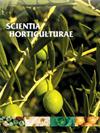The relationship between the degree of infestation with Bactrocera oleae Rossi (Diptera: Tephritidae) and the volatiles released by the olive canopy
IF 3.9
2区 农林科学
Q1 HORTICULTURE
引用次数: 0
Abstract
The olive fruit fly, Bactrocera oleae (Rossi), is the most economically important pest of the olive tree; the fly prefers some cultivars over others, although the reason for this is still unclear. Current research results indicate that volatile compounds of the olive tree have a greater influence on the fly's attraction to a host plant than the physical parameters of the olive fruit. Therefore, the aim of the study was to investigate the relationship between the degree of the olive fruit fly infestation and the volatiles released by the olive leaves and fruits of three cultivars with similar physical fruit parameters, grown in the same olive grove. Lastovka, Frantoio and Leccino cultivars were studied, HS-SPME/GC–MS was performed to determine the profile of volatiles in leaves and fruits and to investigate the relationship between volatiles and the olive fruit fly infestation. Frantoio was the olive cultivar with the highest infestation by the olive fruit fly (39.66 %), followed by Leccino (24 %) and Lastovka (5 %). Among total number of volatiles identified in the study (55), more were detected in the fruits (37) than in the leaves (26). Saturated hydrocarbons and terpenes were the most abundant volatile groups in the fruits, while terpenes were found the most abundant in the leaves. The amounts of (E)-4,8-dimethylnona-1,3,7-triene and heneicosane were highest in the olive fruits of all cultivars tested. Heneicosane and eicosane were mainly released from ripe fruits and strongly correlated with the degree of infestation with the olive fruit fly. In addition, henicosane was the most abundant volatile compound in ripe fruits, along with 2,6-di-tert-butyl-4-methyl-phenol. Therefore, the results of the study suggest that fruit-derived volatiles have the greatest impact on the attraction of the olive fruit fly. The use of plant volatiles as attractants could be an effective tool for the sustainable control of olive trees to reduce the damage caused by the olive fruit fly while avoiding negative impacts on the environment and biodiversity.
Bactrocera oleae Rossi(双翅目:Tephritidae)的侵扰程度与橄榄树冠释放的挥发性物质之间的关系
橄榄果蝇(Bactrocera oleae (Rossi))是橄榄树上最具经济价值的害虫;橄榄果蝇喜欢某些栽培品种而不是其他品种,但其原因尚不清楚。目前的研究结果表明,与橄榄果实的物理参数相比,橄榄树的挥发性化合物对苍蝇对寄主植物的吸引力影响更大。因此,本研究的目的是调查橄榄果蝇的侵扰程度与橄榄叶片和果实释放的挥发性物质之间的关系,这三个果实物理参数相似的栽培品种生长在同一片橄榄树林中。研究人员对 Lastovka、Frantoio 和 Leccino 三个品种进行了研究,通过 HS-SPME/GC-MS,确定了叶片和果实中挥发性物质的特征,并研究了挥发性物质与橄榄果蝇侵扰之间的关系。Frantoio 是受橄榄果蝇侵害最严重的橄榄品种(39.66%),其次是 Leccino(24%)和 Lastovka(5%)。在研究中发现的所有挥发性物质(55 种)中,果实(37 种)中检测到的挥发性物质多于叶片(26 种)。饱和碳氢化合物和萜烯是果实中含量最高的挥发物,而萜烯则是叶片中含量最高的挥发物。在所有测试品种的橄榄果实中,(E)-4,8-二甲基-1,3,7-三烯和新二十烷的含量最高。庚二十烷和二十烷主要从成熟果实中释放出来,与橄榄果蝇的侵扰程度密切相关。此外,庚二十烷和 2,6-二叔丁基-4-甲基苯酚是成熟果实中含量最高的挥发性化合物。因此,研究结果表明,果实中的挥发性物质对橄榄果蝇的吸引力影响最大。使用植物挥发物作为引诱剂可能是对橄榄树进行可持续控制的有效工具,以减少橄榄果实蝇造成的损害,同时避免对环境和生物多样性造成负面影响。
本文章由计算机程序翻译,如有差异,请以英文原文为准。
求助全文
约1分钟内获得全文
求助全文
来源期刊

Scientia Horticulturae
农林科学-园艺
CiteScore
8.60
自引率
4.70%
发文量
796
审稿时长
47 days
期刊介绍:
Scientia Horticulturae is an international journal publishing research related to horticultural crops. Articles in the journal deal with open or protected production of vegetables, fruits, edible fungi and ornamentals under temperate, subtropical and tropical conditions. Papers in related areas (biochemistry, micropropagation, soil science, plant breeding, plant physiology, phytopathology, etc.) are considered, if they contain information of direct significance to horticulture. Papers on the technical aspects of horticulture (engineering, crop processing, storage, transport etc.) are accepted for publication only if they relate directly to the living product. In the case of plantation crops, those yielding a product that may be used fresh (e.g. tropical vegetables, citrus, bananas, and other fruits) will be considered, while those papers describing the processing of the product (e.g. rubber, tobacco, and quinine) will not. The scope of the journal includes all horticultural crops but does not include speciality crops such as, medicinal crops or forestry crops, such as bamboo. Basic molecular studies without any direct application in horticulture will not be considered for this journal.
 求助内容:
求助内容: 应助结果提醒方式:
应助结果提醒方式:


